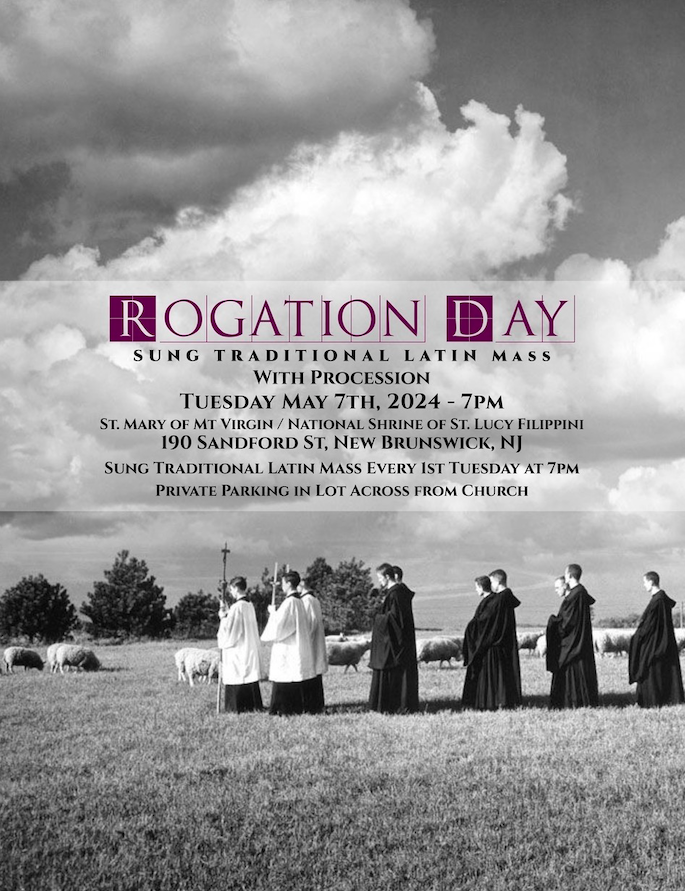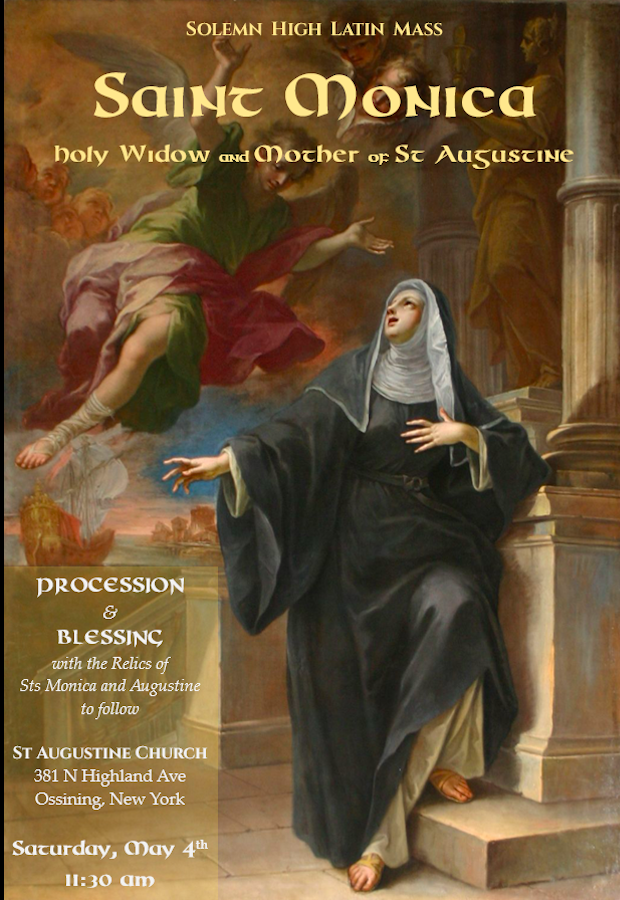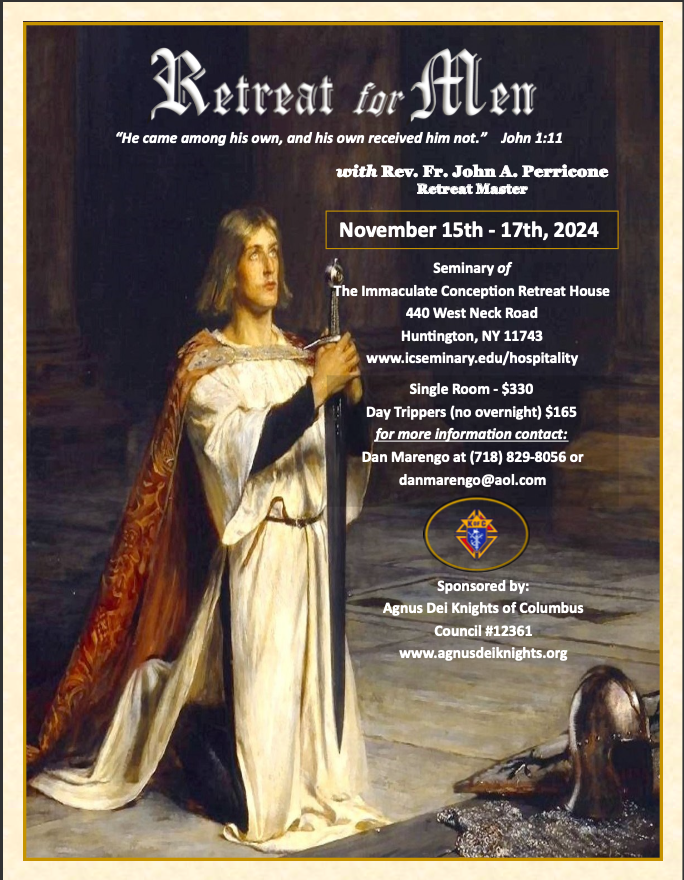
5
May
2
May
Fr. John Hunwicke, RIP
Posted by Stuart Chessman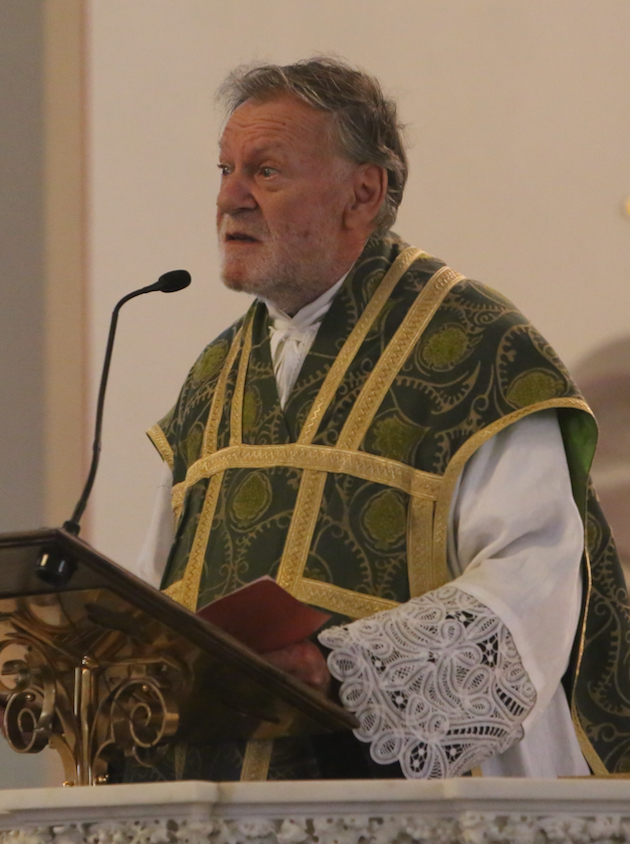
Today I heard the sad news that Fr. John Hunwicke had died on Tuesday, April 30th. He was a member of the Ordinariate of Our Lady of Walsingham.
So many of us became acquainted with him on his blog Mutual Enrichment. An untiring champion of orthodoxy, Latinity and traditional culture, Fr Hunwicke offered a running commentary – now humorous, now acerbic and always erudite – on the (often disastrous) developments in Church and State. I would like to offer some personal reminiscences of Fr. Hunwicke.
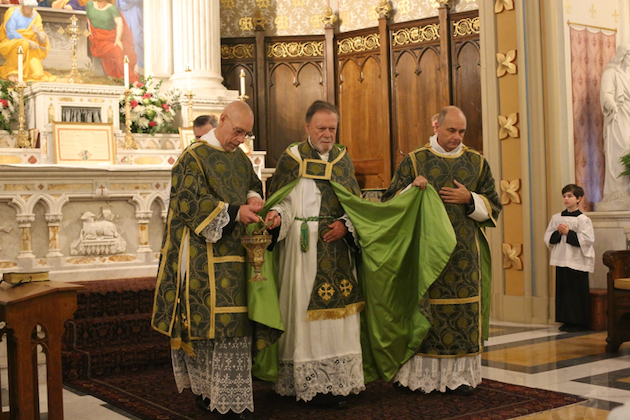
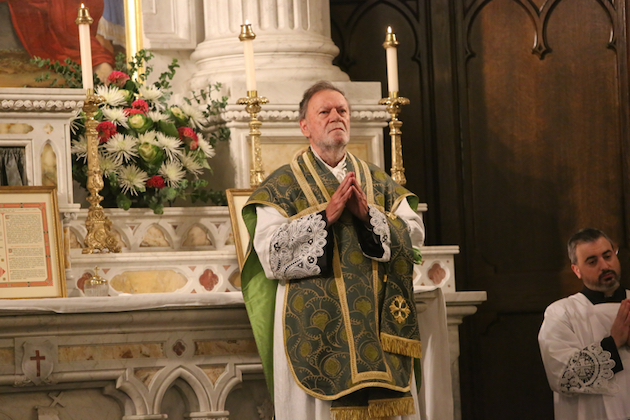
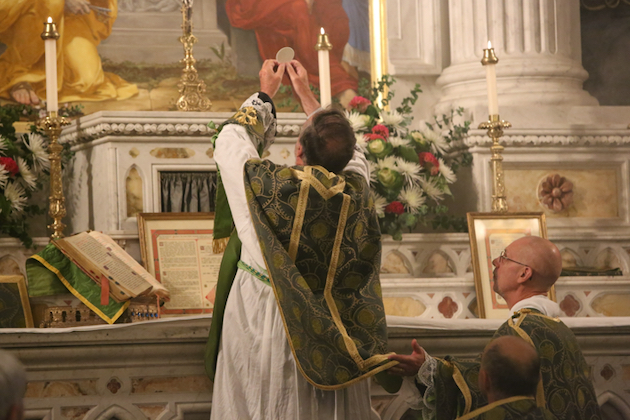
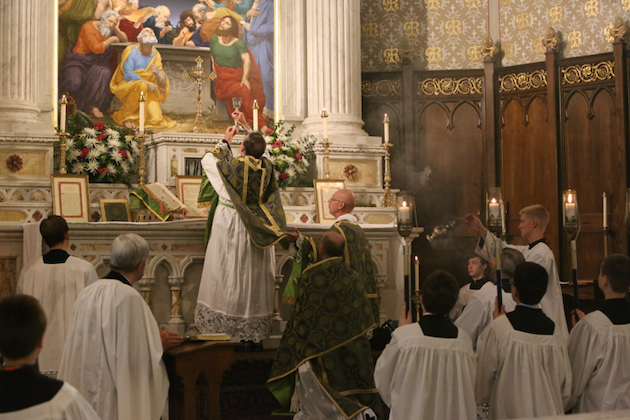
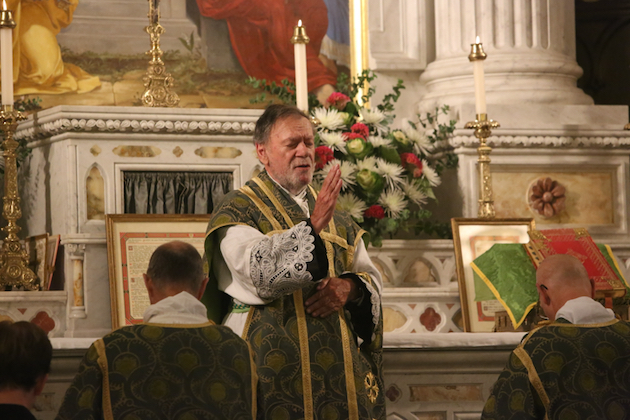
In 2016 the Society of St. Hugh of Cluny had the pleasure of welcoming Fr. Hunwicke to the New York area. He spoke and celebrated mass at St. Mary’s, Norwalk; subsequently he spoke in the so-called “catacombs” of Old St. Patrick’s Cathedral. I’m sure many fondly recall this visit!
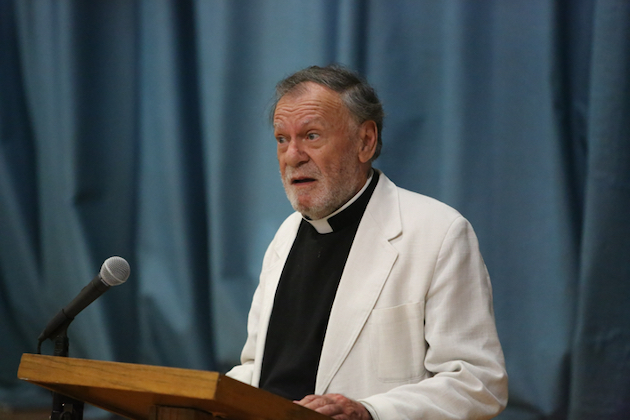
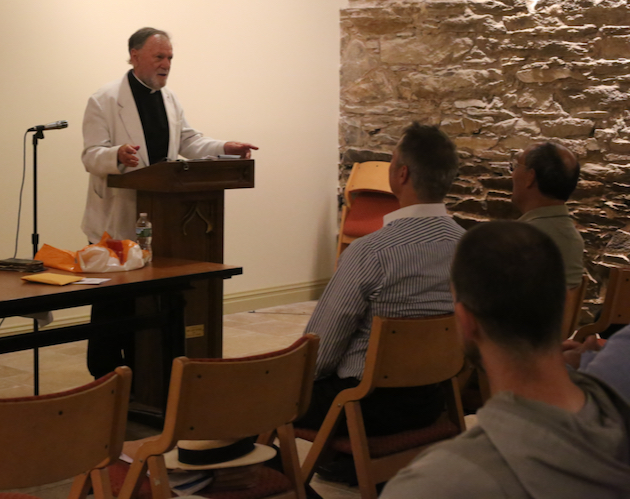
In between his official program. I had the honor of showing Fr. Hunwicke around New York. We visited the Metropolitan Museum of Art and the Frick Collection, where he observed that Mr. Frick had had a simple plan for his collection, instructing his agents “just to buy the best, no matter what it is.” Fr. Hunwicke was very interested in Art Deco – what better place in the world to see it than New York City? Walking around Rockefeller Center (and later St Patrick’s Cathedral) he pointed out errors – sometimes egregious – in a coat of arms here, in a stained glass window there. A tour about town with Fr. Hunwicke was an amazing educational experience – for me!
Fr. Hunwicke later summarized his experiences in and around New York in his inimitable style:
I took the opportunity to avail myself of the very great privilege of celebrating and preaching in the fine church at Norwalk in Connecticut over which a fellow Oxonian, Dr Richard Cipolla of Cardinal College, a hospitable host, presides to such splendid effect. It is most impressive; the liturgy runs like the smoothest clockwork and the Music is in the charge of the mighty, impeccable, and infallible David Hughes. I had the unusual experience of being congratulated by no fewer than two of my hearers on preaching a sermon full of Ciceronian praeteritio. You don’t often get that class of comment on this side of the water.
For his full comments see Greetings from Father Hunwicke on this blog.
We stayed in touch. In 2019 the Society sponsored a Mass in thanksgiving for the canonization of Cardinal Newman at St. Catherine of Siena Church in New York. That Mass featured a new setting by Mr. David Hughes of a hymn written by Father Hunwicke, which begins:
Salve Fundator, Pater et Magister!
To set this hymn to music, Mr. Hughes had to enter into minor negotiations (supported by Fr. Hunwicke) with the Birmingham Oratory, which holds a copyright on it!
Fr. Hunwicke was a unique defender of the faith in our time. May he rest in peace!
30
Apr
In the latest issue (May 2024) of his Catalyst Bill Donohue finally lowers the boom on Francis:
Pope’s Rating Tanking
Why are Catholics who are the most practicing also the least happy with Francis? We know from virtually every survey that these Catholics are mostly orthodox, and it is likely that they are also more attentive to what he has been doing. That may explain their relative dissatisfaction with him.
Bill Donohue seems to be one of those Catholics who has been attentive to what Pope Francis has been doing. He mentions in the article the papal protection of Rupnik and Zanchetta, the favor shown to Pelosi, the measures taken against Bishop Strickland and Cardinal Burke and the “severe restrictions” imposed on the Latin Mass, “alienating millions of Catholics.” I am sure a recent funeral at St. Patrick’s Cathedral (which is not mentioned) also helped Donohue to make up his mind regarding the current pontificate.
I feel sympathy for Bill Donohue and his Catholic League for Religious and Civil Rights. For decades Dohohue has defended the hierarchy and the Church – now and then perhaps in a misguided manner – against all manner of adversaries. Now this same Vatican and hierarchy have largely deserted the conservatives who have expended so much effort on the Church establishment’s behalf. But from such bitter experiences the truth emerges – and that is the most important thing. And I welcome Bill Donohue’s expression of sympathy for persecuted traditionalists. Could it even be that the Catholic League for Religious and Civil Rights will now turn its attention to combatting abuses of power within the Catholic Church itself?
30
Apr
Big Brother is Watching You
Posted by Stuart Chessman
A few doors down from the Munich hotel in which I was recently staying is Trinity Church (Dreifaltigkeitskirche), a modest but magnificent monument of baroque art. It’s located on the Pacellistrasse – named after Pius XII.

The genesis of this church springs from the convoluted political conflicts within the Holy Roman Empire. Bavaria, like Austria, had remained Catholic after the Reformation. In the 17th Century the electors of Bavaria had fought for the Catholic cause against the enemies of the Empire. Yet, despite all that, from 1700 till 1813 the Bavarian rulers more often allied themselves with France against the Holy Roman (later Austrian) emperor. (One thinks of the similar relationship between the two Protestant states of Saxony and Prussia). The result of their rulers’ ambitions for the people of Bavaria was generally disastrous.
That was certainly true of the War of the Spanish Succession, in which the French and Bavarians were disastrously defeated in 1704 by the Imperial forces led by Prince Eugene of Savoy and the English under the Duke of Marlborough.1) It looked like Munich might be burned to the ground. A local holy woman and mystic, Maria Anna Lindmayr, had a vision in which the city would be saved if a vow were taken to build a church to the honor of the Trinity, The “estates” of Bavaria (citizens, nobility and clergy) made this vow and the city was saved. It’s an interesting example of the life of a Catholic “integralist” commonwealth, with the different components of society united around a common faith. This unity was the legacy of the Counter-Reformation.
In 1705-06, outside of Munich, the Bavarians rose up (unsucessfully) against the occupation forces in a legendary struggle that became a critical element of Bavarian consciousness. However, this also created a rift between Austria and Bavaria, the two major German Catholic states, otherwise so similar in culture and language. It was one more element in the increasingly complex political life of the Holy Roman Empire.


The planning and construction, however, went on for years. The architect was Giovanni Antonio Viscardi of Graubunden, Switzerland, who worked mainly in Bavaria. His work is based on the architecture of the baroque churches of Rome. The other artists involved in the construction and decoration were locals. Ironically, most of the work on this building took place under, and with the support of, the Austrian occupation regime led by a deputy of the Holy Roman Emperor. For the elector of Bavaria, Maximilian II Emanuel, had been expelled from his domains after his defeat in 1704 and would be unable to return to Munich until after the war was over in 1714. Trinity church was finally consecrated in 1718.
Early on, a Carmelite monastery was attached to this votive church. Maria Anna Lindmayr eventually became a member of this convent. She died in 1726, widely revered as a saint – yet, after initial efforts, her cause was not pursued further.





Like many baroque churches, the Dreifaltigkeitskirche conveys the impression of a circular centralized space. The focal point of the decoration is the ceiling fresco by Cosmas Damian Asam – one of his earliest works and a foretaste of later masterpieces. It is a vast composition swirling around the image of the Trinity. It’s derived, of course, from the decoration of the ceilings and domes of various Roman churches of the previous century.
Thus Trinity church perfectly illustrates the creative interaction in the 18th century of Roman Baroque models in architecture and painting with native artists and traditions. It helped launch the most glorious period of art in Bavaria and adjacent regions of Germany. And such creative encounters are characteristic of the Holy Roman Empire, of which this church is a remarkable surviving witness. For Trinity was a votive church, inspired by the visions of a mystic and vowed by the estates which together constituted the people of Bavaria in that age. This vow sucessfully warded off the destruction of the city by the forces of the emperor – yet this same emperor enabled the construction of the church. Thus Trinity church testifies to the shared South German Catholic piety of Austrians and Bavarians – yet these peoples inherited from the era in which this church was built a certain resentment and animosity.
So much history of the days of the old Empire can be found just a short stroll from the contrasting world of a modern luxury hotel. And this hotel in the heart of Munich includes – another historical relic but one of a much later age – a Trader Vic’s restaurant! It’s a literal demonstration of Byung-Chul Han’s thesis that in the hyperculture of postmodernity we are all “tourists in Hawaiian shirts,” mixing, yet alienated from, all cultures (including our own). 2)


See generally Bieri, Pius, “Dreifaltigkeitskirche und ehemaliges Karmelitinnenkloster München” in sueddeutscher-Barock.ch.; “Dreifaltigkeitskirche München” (de.wikipedia.org, acccesssed 4/29/2023)
- The final decisive battle of 1704 is known in English as Blenheim. Thus Southey’s famous poem of 1796 After Blenheim.
- Han, Byung-Chul, Hyperculture: Culture and Globalization (translator: Daniel Steuer) at 1 (referencing Nigel Barley) (Polity Press, Cambridge UK and Medford MA USA 2022; original German publication 2005)
28
Apr
Catholics (1973)
Posted by Stuart ChessmanJack Gold, director
Brian Moore, writer
Recently, traditionalists have become aware of a 1973 TV movie Catholics. In the 1970s I read in National Review or Triumph a review of either the movie or the 1972 book upon which it is based. But I only got a chance to see the movie a week ago. I cannot say that Catholics is convincing dramatically. And it’s certainly not a reasoned exploration of the conflict between the traditional mass and the new mass. Rather, the movie depicts various tendencies and tensions within a deeply disturbed organization. It’s clear that Brian Moore, author of the book on which this movie is based and also the scriptwriter, is no great friend of the Catholic Church.
The attention of traditionalists has focused on the prophetic nature of the movie. For today do we not also have a papal persecution of traditionalist Catholics reaching down into the smallest parish? Is not the Vatican issuing documents blatantly contradicting prior teaching, not just that of the ages, but of as recently as two or three years ago? We may not have had Vatican III and IV, mentioned in this film, but we did have John Paul I and II.
Yet we must remember that Catholics, just like George Orwell’s 1984, is primarily describing not a futuristic world but the age in which it appeared. In 1973 the Church had not formally declared that the consecration in the Mass was merely symbolic – but it had empowered a legion of religious who said just that with impunity. It had not openly proclaimed itself a revolutionary organization, but it tolerated, especially in South America, a broad movement which advocated exactly that. The Vatican of Paul VI was still actively seeking to root out the last vestiges of the old liturgical order – such as in England. And the film refers to the great decline in Catholic practice which had already occurred by that time.
Thus, Catholics is powerful witness to the extreme fossilization of the Conciliar Church. As far as the Church establishment is concerned, very little has changed between the age of Paul VI and that of Francis. Indeed, how can there be any change given the Conciliar assumptions of openness to the modern world? Change can only come from further developments in the civil society of the West with which the Church is seeking accommodation. For example, the Church of Catholics is committed to “political” revolution whereas the Church of today is toying with “social” and even “biological” revolution (feminism, LGBT ). Catholics does show the beginnings of this. The leadership of the Catholic Church here sports elegant and very unrevolutionary “business casual” attire more suited to European bars than than the encampments of insurgents.
Clad in such dress, a priest representative of this totally secular Vatican sets forth to squelch the last remnants of traditionalism on a remote island. This visitor cannot relate to the ordinary people he encounters and eventually must reach his destination via helicopter. This new modernist church is contrasted with a strange group of monks on the island. These monks don’t seem to pray very much. On the one occasion they do gather for an ad hoc prayer service they are brusquely sent to their quarters by their abbot. He reminds them that they are not in a contemplative but an active order and should concentrate on doing the manual tasks of the monastery. We learn, moreover, that the abbot lost his faith years ago (in a 1960’s-era “crisis of faith”) and is no resolute defender of tradition at all.
At the end of the day (and of the film), it is the Church establishment that seems to triumph by invoking blind obedience. Having surrendered to the new liturgy, the monks do finally gather for prayer with the abbot but the disturbing face one sees as the film’s final image in no way conveys the impression that a satisfactory spiritual resolution has been attained. The cult of obedience to authority is the only mortar still holding the edifice of the Church together. 1)
It is noteworthy that the dominant dialogue and interactions are entirely between the emissary of Rome and the abbot. The laity and the other monks of the monastery are disregarded and treated as fanatics and fools. Even though some monks pose valid questions regarding the new order these remain hanging in midair, unaddressed. Such as how in religion something can be true one day and the next day be false and even harmful (Ratzinger would later take up this point). I believe this depiction of the contemptuous treatment by the Church of the laity and of the lower ranks of clergy was valid then and now.
Is the confrontation between the abbot and the “new priest” a subtle, perceptive commentary on the 1960s revolution in the Church? Is it suggesting that the old regime had in fact been undermined by hidden unbelief, lack of prayer, concentration on the material aspects of the Church and the cult of obedience? So that when authority proclaimed a new order, resistance crumbled overnight? Perhaps! But one thing Catholics did not get right was the strength of the organized Tradionalist movement, only just getting underway at that time. For it would be led by someone – Archbishop Marcel Lefebvre – who in fact did not set obedience to authority above Catholic tradition and truth.
- Amy Welborn provides a perceptive discussion of Brian Moore’s Catholics. (Obedience:) In the end it was the only card (quoting Brian Moore’s novel); The last refuge, even when none of the arguments make sense – even for the most self-proclaimed open-minded among us.(Amy Welborn) (Charlotte was Both, 9/25/2022 )
For another take on this film see Dr. Peter Kwasniewski’s review at Tradition and Sanity.
28
Apr
28
Apr
This Thursday, May 9, is the Feast of the Ascension, a holy day of obligation. The following churches will offer the Traditional Mass.
Connecticut
St. Mary Church, Norwalk, 8 am, 12:10 pm, 7 pm
Sts. Cyril and Methodius Oratory, Bridgeport, low Mass7:45 am; high Mass 6 pm
Sacred Heart Oratory, Georgetown, Missa Cantata, 6 pm
St. Patrick Oratory, Waterbury, low Mass 8 am; high Mass 6 pm
New York
Holy Innocents Church, New York, NY, low Mass 8 am; high Mass 6 pm
Our Lady of Mount Carmel Shrine, 448 East 116th Street, New York, 7:00 AM Low Mass; 7:45 AM Low Mass; Adoration of the Blessed Sacrament exposed from 9:30 AM to 10:30 AM; 3:00 PM Holy Rosary and Divine Mercy Chaplet; 6:00 PM Confessions; 7:00 PM High Mass of Thanksgiving, 37th Anniversary of Ordination of Father Marian Wierzchowski SAC Pastor
Our Lady of Refuge, Bronx, Missa Cantata 7pm
St. Josaphat Church, Bayside, Queens, 7 pm
St. Paul the Apostle, Yonkers, NY, noon
Annunciation Church, Crestwood, NY, 7 pm
Immaculate Conception, Sleepy Hollow, low Mass 7 pm
St. Matthew, Dix Hills, Long Island, 10:30 AM
St. Rocco, Glen Cove, Long Island, Missa Cantata 7 pm
Sacred Heart, Esopus, 11:30 AM
St. Mary and St. Andrew, Ellenville, NY, 7 PM
Church of the Holy Trinity, Poughkeepsie, 7 pm
New Jersey
Our Lady of Sorrows, Jersey City, 7 pm
Our Lady of Fatima Chapel, Pequannock, 7 am, 9 am, 12 noon, 7 pm
St. Anthony of Padua Oratory, West Orange, low Mass 9 am; high Mass 7 pm
Corpus Christi, South River, Missa Cantata, 7 pm
Shrine Chapel of the Blessed Sacrament, Raritan, 7 pm
St. John the Baptist, Allentown, 7 pm
From Christian Marquandt, President of the Coetus Internationalis Summorum Pontificum
THE APPEAL FOR THE TOTAL FREEDOM OF THE TRADITIONAL LITURGY: AN INTERNATIONAL CAMPAIGN LAUNCHED BY JEAN-PIERRE MAUGENDRE GENERAL DIRECTOR OF RENAISSANCE CATHOLIQUE
Jean-Pierre Maugendre, General Director of Renaissance Catholique, has just launched an appeal, which follows hereafter, setting in motion a campaign throughout the world for the complete freedom of the traditional liturgy. The Coetus Internationalis Summorum Pontificum gratefully welcomes this initiative and joins it forthwith, putting all its resources and possibilities at the disposal of this campaign.
In the decisive moment in which the Church finds itself, anxiously questioning what the continuation of this pontificate will be, it is essential that the liturgical question be brought to the forefront. We have said it, and repeated, and hammered it, the traditional liturgy, directly, celebrated “live” so to speak, or while influencing, “enriching”, the ordinary liturgies of priests, communities, and soon, we hope, dioceses – as they once again turn themselves to traditional things – is the only living and beating heart capable of enacting a recovery of the Church in the midst of our extremely secularized world.
We fully adhere to what Jean-Pierre Maugendre says: “among all the things that can contribute to the internal revival of the Church and to the renewal of her missionary zeal, there is, above all, the worthy and reverent celebration of her liturgy, which can be greatly fostered thanks to the example and the presence of the traditional Roman liturgy.”
The purest lex orandi of the Roman Church is always followed, certainly at the cost of significant efforts, by the dissemination of the lex credendi of which it is a reflection. It is therefore natural for the mass to be accompanied by the Catholic catechism.
Time is getting short, as Saint Paul says (1 Corinthians 7, 29). There is no longer time to always beg for permissions and tolerances, granted and given one day, and cancelled and taken back the day after, which has been constantly happening again and again. Benedict XVI in Summorum Pontificum recalled the principle of the freedom of the traditional mass. What we demand now is simply that we be assured of the reality of this freedom, and that is actually the single thing we wish to hear, nothing else.
To all the considerations one may make about the current situation of the Church (the dramatic collapse of Western Catholicism, now also in Italy; the mortiferous scent of the end of the pontificate), which indicate that we must speak and act with force, we would wish to add yet another element, minor, but symptomatic nonetheless. It is no secret that the SSPX prepares its faithful for the consecration of new bishops. The event will not produce the same shock as in 1988. Today it will be an element which will increase the ferment of what remains of a weakened and divided Catholicism. In chaos, life can be found, if at least we know how to look for it and direct it. Let us not forget the following: the main point of Mgr Lefebvre’s “revolt” was the maintenance of the traditional liturgy. Now, the full restitution – and not to a third or a quarter as up to now – of the freedom of the Mass will be a means of allowing for the liturgical periphery, i.e. the SSPX, not to have to be back at the centre of things, but instead, to be able simply to be back in the centre, once the traditional liturgy will itself be finally reinstated there again.
Rome today buzzes with nothing but talk of a conclave. And as a result, with talk of the informal “programs” that cardinals are already setting out. Well, the appeal of Jean-Pierre Maugendre contributes to this. Or rather, it reminds us that the liturgical stone that the demolitionists of the Church rejected will once again become the cornerstone.
Christian Marquant
President of the CISP
International Campaign for the Total Freedom of the Traditional Liturgy
Being a Catholic in 2024 is no easy endeavor. The West is undergoing a massive de-Christianization, so much so that Catholicism appears to be vanishing from the public sphere. Elsewhere, the number of Christians being persecuted for their faith is on the rise. What’s more,the Church has been struck by an internal crisis that manifests itself in a decline in religiouspractice, a downswing in priestly and religious vocations, a decrease in sacramental practice, and even a growing dissension between priests, bishops and cardinals which, until very recently, was utterly unthinkable. Yet, among all the things that can contribute to the internalrevival of the Church and to the renewal of her missionary zeal, there is, above all, the worthy and reverent celebration of her liturgy, which can be greatly fostered thanks to the example and the presence of the traditional Roman liturgy.
Despite all the attempts that have been made to suppress it, especially during the present pontificate, it lives on, continuing to spread and to sanctify the Christian people who are blessed to be able to benefit from it. It bears abundant fruits of piety, as well as an increase of vocations and of conversions. It attracts young people and is the fount of many flourishing works, especially in schools, and is accompanied by a solid catechesis. No one can deny that it is a vector for the preservation and transmission of the faith and religious practice in the midst of a waning of religious belief and a dwindling number of believers. This Mass, due to its venerable antiquity, can boast of having sanctified countless souls over the centuries. Among other vital forces still active in the Church, this form of liturgical life stands out because of the stability given to it by an uninterrupted lex orandi.
Certainly, some places of worship have been granted, or rather tolerated, where this liturgy can be celebrated, but too often what has been given by one hand is taken back by the other, without, however, ever managing to make it vanish.
Since the massive decline during the period immediately following the Second Vatican Council, every attempt has been made on numerous occasions to revive religious practice, to increase the number of priestly and religious vocations, and to preserve the faith of the Christian people. Everything, except letting the people experience the traditional liturgy, by giving the Tridentine liturgy a fair chance. Today, however, common sense urgently demands that all the vital forces in the Church be allowed to live and prosper, and in particular the one which enjoys a right dating back to over a millennium.
Let there be no mistake: the present appeal is not a petition to obtain a new tolerance as in 1984 and 1988, nor even a restoration of the status granted in 2007 by the motu proprio Summorum Pontificum, which, recognizing in principle a right, has in fact been reduced to a regime of meagerly granted permissions.
As lay people, it is not for us to pass judgment on the Second Vatican Council, its continuity or discontinuity with the previous teaching of the Church, the merits, or not, of the reforms that resulted from it, and so on. On the other hand, it is necessary to defend and transmit the means that Providence has employed to enable a growing number of Catholics to preserve the faith, to grow in it, or to discover it. Thetraditional liturgy plays an essential role in this process, thanks to its transcendence, its beauty, its timelessness and its doctrinal certainty.
For this reason, we simply ask, for the sake of the true freedom of the children of God in the Church, that the full freedom of the traditional liturgy, with the free use of all its liturgical books, be granted, so that, without hindrance, in the Latin rite, all the faithful may benefit from it andall clerics may celebrate it.
Jean-Pierre Maugendre, Managing Director of Renaissance Catholique, Paris, France
(Ce texte a été traduit et diffusé en allemand, anglais, espagnol, français, italien, néerlandais et portugais.)
This appeal is not a petition to be signed, but a message to be disseminated, possibly to be taken up again in any form that may seem appropriate, and to be brought and explained to the cardinals, bishops and prelates of the universal Church.
Si Renaissance catholique a l’initiative de cette campagne, c’est uniquement pour se faire l’interprète d’un large désir en ce sens qui se manifeste dans l’ensemble du monde catholique. Cette campagne n’est pas la sienne, mais celle de tous ceux qui y participeront, la relayeront, l’amplifieront, chacun à leur manière.
20
Apr
Contact us
Register
- Registration is easy: send an e-mail to contact@sthughofcluny.org.
In addition to your e-mail address, you
may include your mailing addresss
and telephone number. We will add you
to the Society's contact list.
Search
Categories
- 2011 Conference on Summorum Pontifcum (5)
- Book Reviews (95)
- Catholic Traditionalism in the United States (24)
- Chartres pIlgrimage (17)
- Essays (176)
- Events (670)
- Film Review (7)
- Making all Things New (44)
- Martin Mosebach (34)
- Masses (1,343)
- Mr. Screwtape (46)
- Obituaries (15)
- On the Trail of the Holy Roman Empire (22)
- Photos (347)
- Pilgrimage Summorum Pontificum 2021 (7)
- Pilgrimage Summorum Pontificum 2022 (6)
- Pilgrimage Summorum Pontificum 2023 (4)
- Sermons (79)
- St. Mary's Holy Week 2019 (10)
- St. Mary's Holy Week 2022 (7)
- St. Mary's Holy Week 2023 (7)
- St. Mary's Holy Week 2024 (6)
- Summorum Pontificum Pilgrimage 2024 (2)
- Summorum Pontificum Pilgrimage 2025 (1)
- The Churches of New York (198)
- Traditionis Custodes (49)
- Uncategorized (1,369)
- Website Highlights (15)
Churches of New York
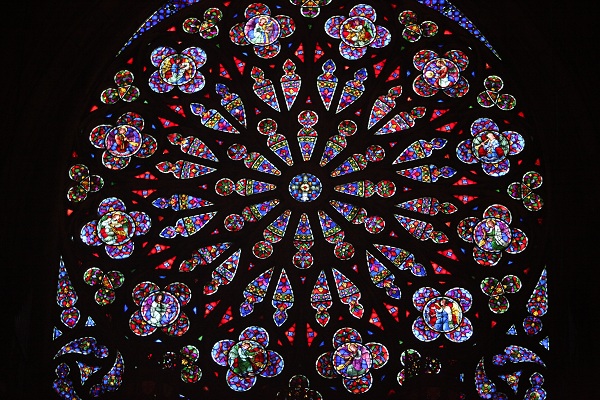
Holy Roman Empire
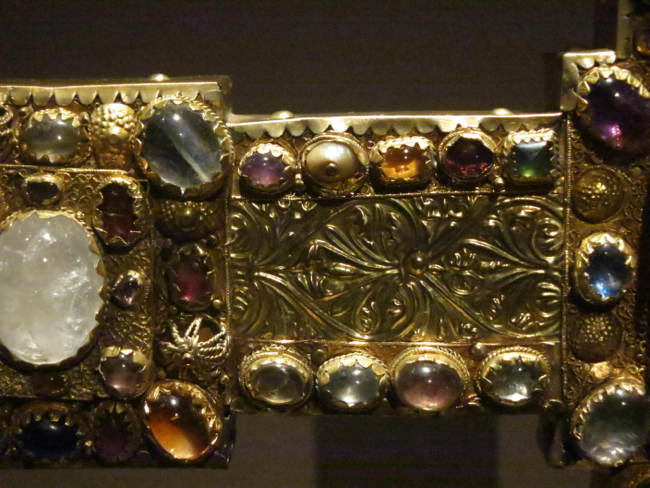
Website Highlights
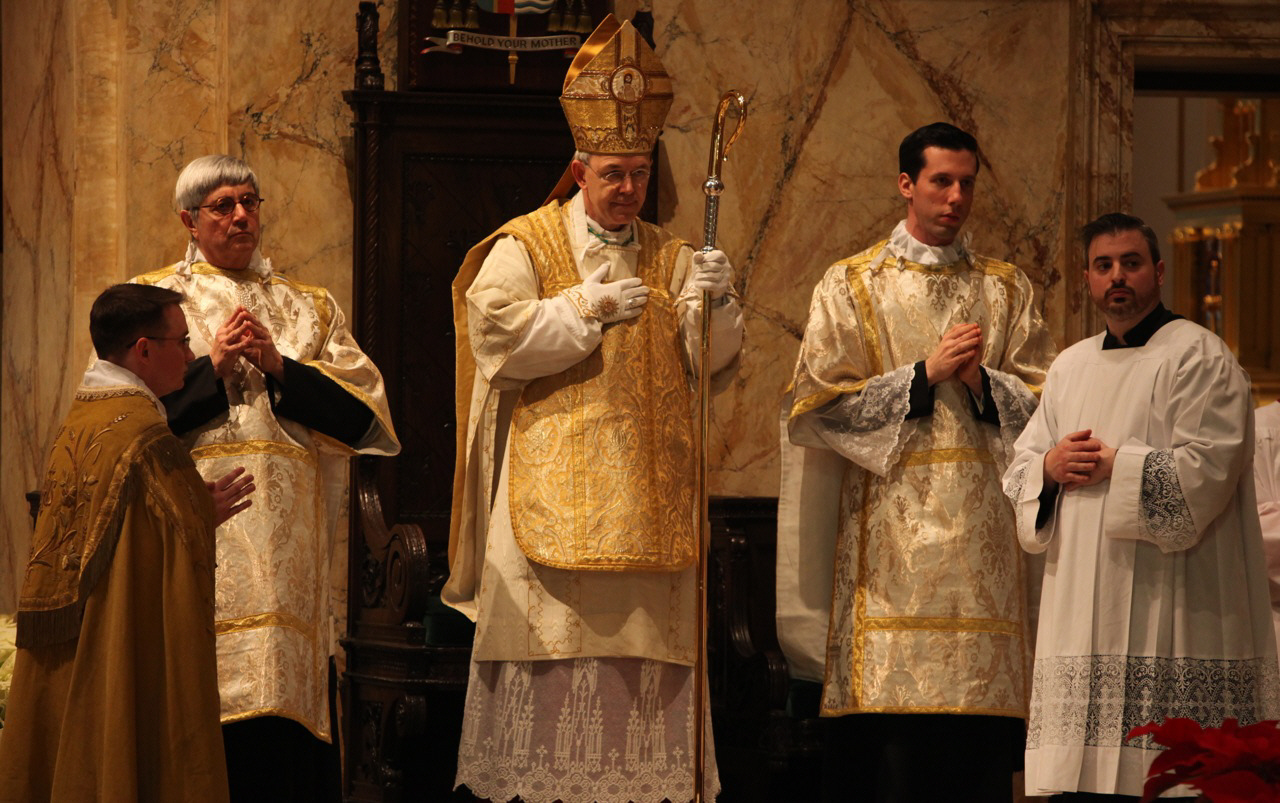
Archives
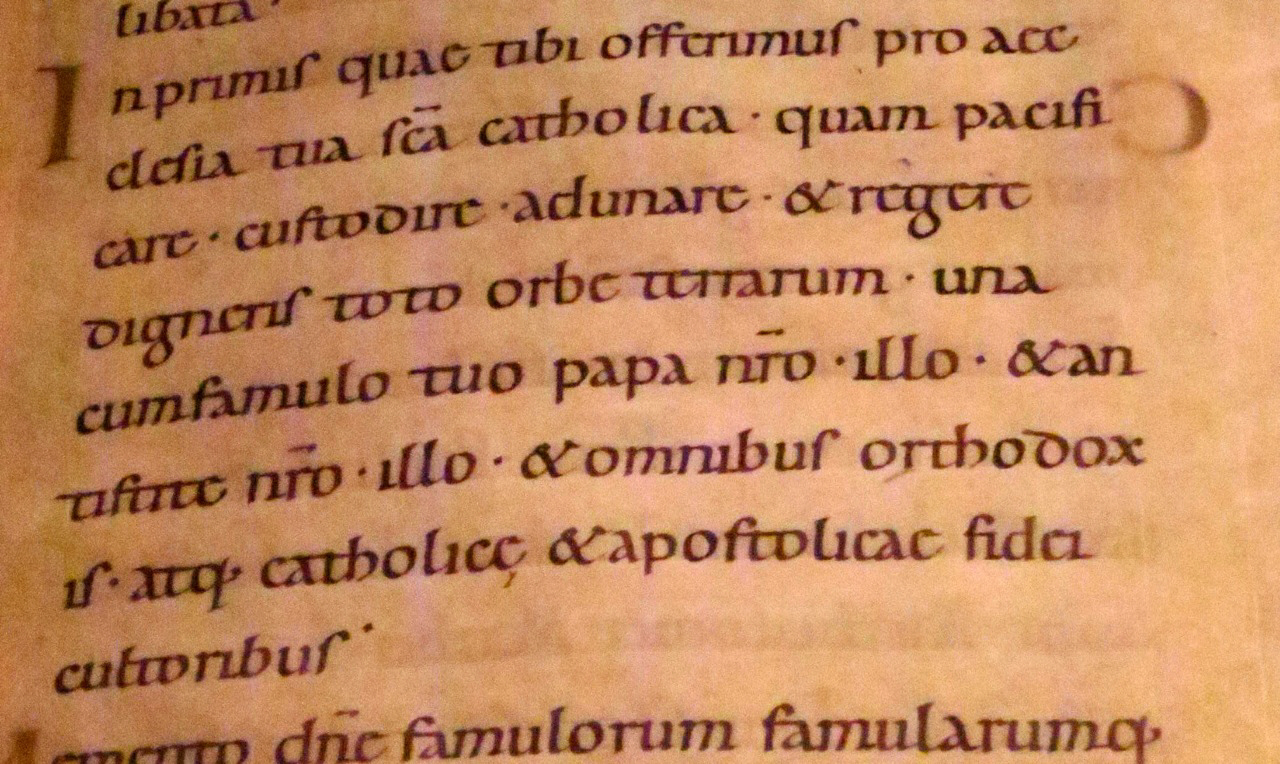
[powr-hit-counter label="2775648"]

